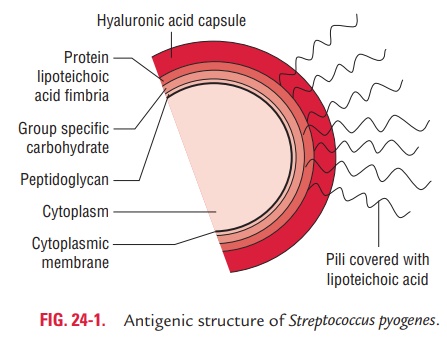Chapter: Microbiology and Immunology: Bacteriology: Streptococcus and Enterococcus
Cell Wall Components and Antigenic Structure - Streptococcus pyogenes
Cell Wall Components and Antigenic Structure
The cell wall of S. pyogenes consists of the following components (Fig. 24-1):

◗ Group-specific carbohydrate
The cell wall contains a group-specific polysaccharide that forms approximately 10% of the dry weight of the cell. It is a polymer ofN-acetylglucosamine and rhamnose. It is nontoxic and hapten in rabbits. On the basis of group-specific carbo-hydrate (C) antigen, S. pyogenes strains have been divided into 21 groups (A–W) except I and J by Lancefield, hence are known as Lancefield groups. The “C” antigen can be extracted by the following methods:
· Acid extraction with hydrochloric acid (Lancefield method ),
· Formamide extraction at 150°C (Fuller’s method ),
· Autoclaving (Rantz and Randall’s method ), and
· Enzyme extraction (Maxted’s method ).
After the extraction, the carbohydrate component is treated with type-specific antiserum by a precipitation reaction or by immunofluorescence for grouping of the isolates of S.pyogenes.
◗ Type-specific proteins
The cell wall of S. pyogenes has three major proteins, M, T, and R proteins. These proteins are useful for serologic typing (Griffith typing) of S. pyogenes.
M protein: M protein is the most important protein. It isacid- and heat-stable and trypsin-sensitive. It is the chief viru-lence factor of the cocci. It inhibits phagocytosis and facilitates the attachment of cocci to epithelial cells. M protein, a complex alpha-helix, consists of carboxyl terminus and an amino termi-nus. The carboxyl terminus is bound to the cytoplasmic mem-brane and is a highly conserved structure. The amino terminus is present through the cell wall to the cell surface and is highly variable. This variable component is responsible for antigenic differences in the M protein and based on that S. pyogenes is divided into more than 80 (l–60) serotypes. M proteins are fur-ther subdivided into class I and class II protein molecules:
· Antibodies develop against the exposed constant (C) region of the class I M proteins and are responsible for the patho-genesis of rheumatic fever.
· In contrast, antibodies do not develop against class II M proteins.
T proteins: These are trypsin-resistant (T) proteins and areacid and heat labile. T typing of strains of S. pyogenes is useful in the epidemiological surveillance of the infection caused by cocci.
R proteins: These are pepsin sensitive but trypsin resistant.These proteins are not important for typing the strains.
◗ Other cell surface components
Peptidoglycan, lipoteichoic acid, and F proteins are other com- ponents of the cell wall of S. pyogenes. Peptidoglycan confers rigidity to the cell wall. It is also responsible for producing fever, dermal and cardiac necrosis in animals, and lysis of erythrocytes
Related Topics